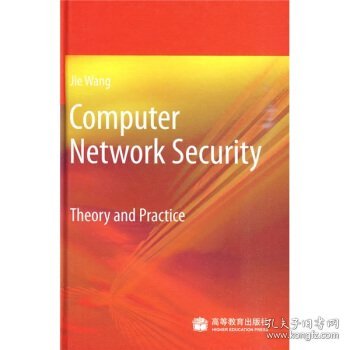Computer Network Security:Theory And Practice
举报
-
作者:
[美] 王杰 著
-
出版社:
高等教育出版社
-
ISBN:
9787040241624
-
出版时间:
2008-09
-
版次:
1
-
装帧:
平装
-
开本:
16开
-
纸张:
胶版纸
-
页数:
384页
-
字数:
99999千字
-
作者:
[美] 王杰 著
-
出版社:
高等教育出版社
-
ISBN:
9787040241624
-
出版时间:
2008-09
-
纸张:
胶版纸
-
页数:
384页
-
字数:
99999千字
售价
¥
14.00
2.9折
定价
¥48.00
品相
九五品
上书时间2024-03-17
卖家超过10天未登录
手机购买
![]()
微信扫码访问
-
-
商品描述:
-
基本信息
书名:Computer Network Security:Theory And Practice
定价:48.00元
作者:[美] 王杰 著
出版社:高等教育出版社
出版日期:2008-09-01
ISBN:9787040241624
字数:430000
页码:384
版次:1
装帧:平装
开本:16开
商品重量:
编辑推荐
内容提要
《Computer Network Security:Theory And Practice》 introduces to the reader a complete and concise view of network security. It provides in-depth theoretical coverage of recent advancements and practical solutions to network security threats. Thiook cabe used for a one-semester network security course for graduate and upper-level undergraduate students, as well as a reference for IT professionals. Dr. Wang haeeProfessor of Computer Science at the University of Massachusetts Lowell since 2001, Director of its Center for Network and InformatioSecurity since 2004, and Chairmaof its Department of Computer Science since 2007.
目录
1 Network Security Overview1.1 Missioand Definitions1.2 CommoAttacks and Defense Mechanisms1.2.1 Eavesdropping1.2.2 Cryptanalysis1.2.3 Password Pilfering1.2.4 Identity Spoofing1.2.5 Buffer-Overflow Exploitations1.2.6 Repudiation1.2.7 Intrusion1.2.8 Traffic Analysis1.2.9 Denial of Service Attacks1.2.10 Malicious Software1.3 Attacker Profiles1.3.1 Hackers1.3.2 Script Kiddies1.3.3 Cyber Spies1.3.4 Vicious Employees1.3.5 Cyber Terrorists1.3.6 Hypothetical Attackers1.4 Basic Security Model1.5 Security Resources1.6 Closing Remarks1.7 Exercises2 Data EncryptioAlgorithms2.1 Data EncryptioAlgorithm DesigCriteria2.1.1 ASCII Code2.1.2 XOR Encryption2.1.3 Criteria of Data Encryptions2.1.4 ImplementatioCriteria2.2 Data EncryptioStandard2.2.1 Feistels Cipher Scheme2.2.2 DES Subkeys2.2.3 DES SubstitutioBoxes2.2.4 DES Encryption2.2.5 DES Decryptioand Correctness Proof2.2.6 DES Security Strength2.3 Multiple DES2.3.1 Triple-DES with Two Keys2.3.2 2DES and 3DES/32.3.3 Meet-in-the-Middle Attacks o2DES2.4 Advanced EncryptioStandard2.4.1 AES Basic Structures2.4.2 AES S-Boxes2.4.3 AES-128 Round Keys2.4.4 Add Round Keys2.4.5 Substitute-Bytes2.4.6 Shift-Rows2.4.7 Mix-Columns2.4.8 AES-128 Encryption2.4.9 AES-128 Decryptioand Correctness Proof2.4.10 Galois Fields2.4.11 Constructioof the AES S-Box and Its Inverse ...2.4.12 AES Security Strength2.5 Standard Block-Cipher Modes of Operations2.5.1 Electronic-Codebook Mode2.5.2 Cipher-Block-Chaining Mode2.5.3 Cipher-Feedback Mode2.5.4 Output-Feedback Mode2.5.5 Counter Mode2.6 Stream Ciphers2.6.1 RC4 Stream Cipher2.6.2 RC4 Security Weaknesses2.7 Key Generations2.7.1 ANSI X9.17 PRNG2.7.2 BBS Pseudorandom Bit Generator2.8 Closing Remarks2.9 Exercises3 Public-Key Cryptography and Key Management3.1 Concepts of Public-Key Cryptography3.2 Elementary Concepts and Theorems iNumber Theory3.2.1 Modular Arithmetic and Congruence Relations3.2.2 Modular Inverse3.2.3 Primitive Roots3.2.4 Fast Modular Exponentiation3.2.5 Finding Large Prime Numbers3.2.6 The Chinese Remainder Theorem3.2.7 Finite Continued Fractions3.3 Diffie-HellmaKey Exchange3.3.1 Key Exchange Protocol3.3.2 Man-in-the-Middle Attacks3.3.3 Elgamai PKC3.4 RSA Cryptosystem3.4.1 RSA Key Pairs, Encryptions, and Decryptions3.4.2 RSA Parameter Attacks3.4.3 RSA Challenge Numbers3.5 Elliptic-Curve Cryptography3.5.1 Commutative Groups oElliptic Curves3.5.2 Discrete Elliptic Curves3.5.3 ECC Encodings3.5.4 ECC Encryptioand Decryption3.5.5 ECC Key Exchange3.5.6 ECC Strength3.6 Key Distributions and Management3.6.1 Master Keys and SessioKeys3.6.2 Public-Key Certificates3.6.3 CA Networks3.6.4 Key Rings3.7 Closing Remarks3.8 Exercises4 Data Authentication4.1 Cryptographic Hash Functions4.1.1 DesigCriteria of Cryptographic Hash Functions ..4.1.2 Quest for Cryptographic Hash Functions4.1.3 Basic Structure of Standard Hash Functions4.1.4 SHA-5124.1.5 WHIRLPOOL4.2 Cryptographic Checksums4.2.1 Exclusive-OR Cryptographic Checksums4.2.2 DesigCriteria of MAC Algorithms4.2.3 Data AuthenticatioAlgorithm4.3 HMAC4.3.1 DesigCriteria of HMAC4.3.2 HMAC Algorithm4.4 Offset Codebook Mode of Operations4.4.1 Basic Operations4.4.2 OCB Encryptioand Tag Generation4.4.3 OCB Decryptioand Tag Verification4.5 Birthday Attacks4.5.1 Complety Upper Bound of Breaking Strong CollisioResistance4.5.2 Set IntersectioAttack4.6 Digital Signature Standard4.7 Dual Signatures and Electronic Transactions4.7.1 Dual Signature Applications4.7.2 Dual Signatures and Electronic Transactions4.8 Blind Signatures and Electronic Cash4.8.1 RSA Blind Signatures4.8.2 Electronic Cash4.9 Closing Remarks4.10 Exercises5 Network Security Protocols iPractice5.1 Crypto Placements iNetworks5.1.1 Crypto Placement at the ApplicatioLayer5.1.2 Crypto Placement at the Transport Layer5.1.3 Crypto Placement at the Network Layer5.1.4 Crypto Placement at the Data-Link Layer5.1.5 Hardware versus Software Implementations of Cryptographic Algorithms5.2 Public-Key Infrastructure5.2.1 X.509 Public-Key Infrastructure5.2.2 X.509 Certificate Formats5.3 IPsec: A Security Protocol at the Network Layer5.3.1 Security Association5.3.2 ApplicatioModes and Security Associations5.3.3 AH Format5.3.4 ESP Format5.3.5 Secret Key Determinatioand Distribution5.4 SSL/TLS: Security Protocols at the Transport Layer5.4.1 SSL Handshake Protocol5.4.2 SSL Record Protocol5.5 PGP and S/MIME: E Security Protocols5.5.1 Basic Emall Security Mechanisms5.5.2 PGP5.5.3 S/MIME5.6 Kerberos: AAuthenticatioProtocol5.6.1 Basic Ideas5.6.2 Single-Realm Kerberos5.6.3 Multiple-Realm Kerberos5.7 SSH: Security Protocols for Remote Logins5.8 Closing Remarks5.9 Exercises6 Wireless Network Security6.1 Wireless Communications and 802.11 WLAN Standards6.1.1 WLAN Architecture6.1.2 802.11 Essentials6.1.3 Wireless Security Vulnerabilities6.2 WEP6.2.1 Device Authenticatioand Access Control6.2.2 Data Integrity Check6.2.3 LLC Frame Encryption6.2.4 Security Flaws of WEP6.3 WPA6.3.1 Device Authenticatioand Access Controls6.3.2 TKIP Key Generations6.3.3 TKIP Message Integrity Code6.3.4 TKIP Key Ming6.3.5 WPA Encryptioand Decryption6.3.6 WPA Security Strength and Weaknesses6.4 IEEE 802.1 li/WPA26.4.1 Key Generations6.4.2 CCMP Encryptions and MIC6.4.3 802.11i Security Strength and Weaknesses6.5 Bluetooth Security6.5.1 Piconets6.5.2 Secure Pairings6.5.3 SAFER+ Block Ciphers6.5.4 Bluetooth Algorithms El, E21, and E226.5.5 Bluetooth Authentication6.5.6 A PIN Cracking Attack6.5.7 Bluetooth Secure Simple Pairing6.6 Wireless Mesh Network Security6.7 Closing Remarks6.8 Exercises7 Network Perimeter Security7.1 General Framework7.2 Packet Filters7.2.1 Stateless Filtering7.2.2 Stateful Filtering7.3 Circuit Gateways7.3.1 Basic Structures7.3.2 SOCKS7.4 ApplicatioGateways7.4.1 Cache Gateways7.4.2 Stateful Packet Inspections7.5 Trusted Systems and BastioHosts7.5.1 Trusted Operating Systems7.5.2 Bastiohosts and Gateways7.6 Firewall Configurations7.6.1 Single-Homed BastioHost System7.6.2 Dual-Homed BastioHost System7.6.3 Screened Subnets7.6.4 Demilitarized Zones7.6.5 Network Security Topology7.7 Network Address Translations7.7.1 Dynamic NAT7.7.2 Virtual Local-Area Networks7.7.3 Small Office and Home Office Firewalls7.8 Setting Up Firewalls7.8.1 Security Policy7.8.2 Building A Linux Stateless Packet Filter7.9 Closing Remarks7.10 Exercises8 The Art of Anti Malicious Software8.1 Viruses8.1.1 Virus Types8.1.2 Virus InfectioSchemes8.1.3 Virus Structures8.1.4 Compressor Viruses8.1.5 Virus Disseminations8.1.6 Win32 Virus InfectioDissection8.1.7 Virus CreatioToolkits8.2 Worms8.2.1 CommoWorm Types8.2.2 The Morris Worm8.2.3 The Melissa Worm8.2.4 E Attachments8.2.5 The Code Red Worm8.2.6 Other Worms Targeted at Microsoft Products8.3 Virus Defense8.3.1 Standard Scanning Methods8.3.2 Anti-Virus Software Products8.3.3 Virus Emulator8.4 TrojaHorses8.5 Hoaxes8.6 Peer-to-Peer Security8.6.1 P2P Security Vulnerabilities8.6.2 P2P Security Measures8.6.3 Instant Messaging8.7 Web Security8.7.1 Basic Types of Web Documents8.7.2 Security of Web Documents8.7.3 ActiveX8.7.4 Cookies8.7.5 Spyware8.7.6 AJAX Security8.7.7 Safe Web Surfing8.8 Distributed Denial of Service Attacks8.8.1 Master-Slave DDoS Attacks8.8.2 Master-Slave-Reflector DDoS Attacks8.8.3 DDoS Attacks Countermeasures8.9 Closing Remarks8.10 Exercises9 The Art of IntrusioDetection9.1 Basic Ideas of IntrusioDetection9.1.1 Basic Methodology9.1.2 Auditing9.1.3 IDS Components9.1.4 IDS Architecture9.1.5 IntrusioDetectioPolicies9.1.6 Unacceptable Behaviors9.2 Network-Based Detections and Host-Based Detections9.2.1 Network-Based Detections9.2.2 Host-Based Detections9.3 Signature Detections9.3.1 Network Signatures9.3.2 Host-Based Signatures9.3.3 Outsider Behaviors and Insider Misuses9.3.4 Signature DetectioSystems9.4 Statistical Analysis9.4.1 Event Counter9.4.2 Event Gauge9.4.3 Event Timer9.4.4 Resource Utilization9.4.5 Statistical Techniques9.5 Behavioral Data Forensics9.5.1 Data Mining Techniques9.5.2 A Behavioral Data Forensic Example9.6 Honeypots9.6.1 Types of Honeypots9.6.2 Honeyd9.6.3 MWCollect Projects9.6.4 Honeynet Projects9.7 Closing Remarks9.8 ExercisesA 7-bit ASCII codeB SHA-512 Constants (ihexadecimal)..C Data Compressiousing ZIPD Base64 EncodingE Cracking WEP Keys using WEPCrackE.1 System SetupE.2 Experiment DetailsE.3 Sample CodeF AcronymsReferencesIndex
作者介绍
序言

![]()
孔网啦啦啦啦啦纺织女工火锅店第三课
开播时间:09月02日 10:30
即将开播,去预约


直播中,去观看

 占位居中
占位居中




 直播中,去观看
直播中,去观看